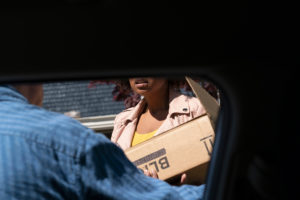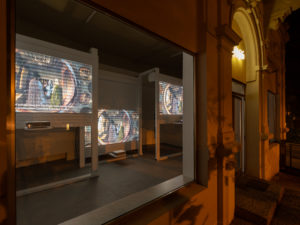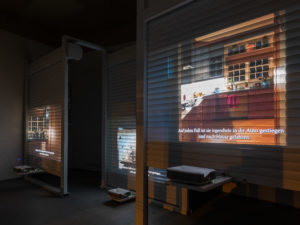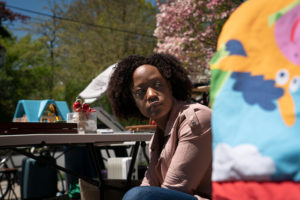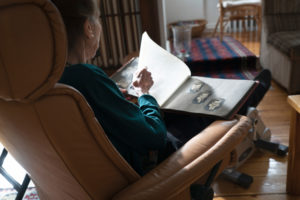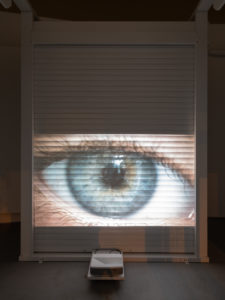11.22 Omer Fast Garage Sale
More
His practice draws on cinematic stylistic devices including blended narrative levels, altered time structures, slippage between film plot and production set, and reenactment—strategies that allow him to create dense visual worlds that help negotiate the process of historiography and collective memory. Recurring themes in Fast’s films include recollection as a cornerstone of human identity (Remainder, 2015), families grappling with tragic events, and psychological coping strategies with absurd tendencies (Continuity, 2012). August (2016) finds Fast focusing on the life and work of August Sander (1876–1964), the legendary Cologne photographer whose dreamlike sequences show him to have been haunted at the end of his life by the death of his son and the figures he photographed. More recent works including The Invisible Hand (2018) mark the first time the artist can be seen experimenting with VR and digital technologies. His films are often presented in specially designed spatial installations: theatrical or cinematic mises-en-scène that turn the audience itself into protagonists.
Fast’s film Garage Sale begins with a heavily pixelated image. The image zooms out and pixels become smaller, allowing us to better distinguish the contours of human figures in an interior space. This cropped detail of a larger image shows what appears to be a mirror, eventually recognizable as the picture-within-the-picture detail from the famed Arnolfini Portrait by Early Netherlandish painter Jan van Eyck. The 1434 rendering of Italian merchant Giovanni di Nicolao Arnolfini and his bride is currently on view in the National Gallery in London. Art historical interpretations vary as to whether the two subjects are already or recently married, in the process of taking their vows, or are still engaged. A clicking sound punctuates the film’s entire soundtrack—an effect recalling the photographic snap of a shutter closing in an analog camera. The film’s unseen female protagonist gives a detailed account of her fascination with the painting and of a project that failed to materialize; throughout, she interrupts her own narrative flow with terse instructions to another person off screen, presumably the camera operator. The camera pans to reveal the painting on a puzzle box lid; further clicks reveal the overall setting for that box: a yard sale, more specifically a hodgepodge of cast-off, unused and disorganized odds and ends sprawled in front of a suburban New Jersey home. Within a few minutes, the narrator has connected Van Eyck’s painting to Erwin Panofsky, the renowned German-born Jewish art historian who published a close analysis of the portrait in 1934. A close-up of a photograph of a semi-detached house in Hanover—home to one of the narrator’s husband’s relatives—is followed by shots leading further into the interior. Viewers find themselves inside Tante Klara’s living room, where the husband’s aunt is pictured leafing through a photo album.
Unspooling from and around this introductory scene is a complex, interlocking frame story linking various times, (family) histories and biographies, discourses on cultural heritage, migration, and racism, but also objects/artifacts and historical personalities on a number of narrative levels. One narrative thread explores the question of how traumatic events are processed in a family, how the memory of such events is passed on from one generation to the next: sometimes with suppression and secrecy, at other times in a more unvarnished version. Subsequent images in Garage Sale reveal a double portrait of two men in SS uniforms standing in front of a semi-detached house in Hanover. The two men, identified as the aunt’s twin uncles Uncle Benno and Uncle Manfred, open a crack in the past, enabling us to peer into it. In an instant, actors in a reenactment bring the black-and-white photograph to life. We hear no further details about the actual past under the Nazi regime or how her husband’s relatives were involved. Instead, the protagonist contemplates the absence of that information in her interaction with the aunt, an instance she describes as “a brief velvety moment swarming with conflicting possibilities,” a moment spent in shared silence as the two women look at the photograph. She asks a series of open questions that are never answered, as if waiting for the viewer’s response.
A postcard of the Arnolfini double portrait, seen propped against books on a bookshelf, ultimately serves the protagonist’s transition to an art-historical digression on Panofsky’s interpretation of the painting. Immediately after, we see the following scene play out back in the New Jersey suburb home: Karen, the white homeowner, carries a cardboard box containing one of her husband Ted’s family heirlooms out to the garage sale. It is a statue depiction of a Black jockey, a racist lawn ornament. Leona, an African-American neighbor, peers into the box and discovers the toxic object. Karen apologizes for the object, but Leona insists on buying the jockey and does not allow Ted to stop her. And yet that same evening, she returns the box with the statue. The narrator reports on a later Zoom conversation with Leona, the protagonist of her failed project, before pointedly telling viewers that “the Zoom conversation never took place. The whole project was entirely fictional.” The admission casts doubt on the entire story once again; the artist allows the narrative house of cards to collapse in the viewer’s mind. It is a moment that also brings into focus the dual role of the narrator as a stand-in for Fast himself. Still—and also in her presence as a disembodied voiceover—she is a distanced figure, one who embraces aspects of Brechtian alienation: She directly addresses viewers several times, comments on the failure of the project, and continually interrupts the flow of her own story with instructions to the camera operator.
Eventually the film circles back to the painting by Jan van Eyck. In another interpretation by the American art historian Linda Seidel, it becomes clear that the painting, “can be seen as a guarantor of circumstances that were wished for—a future reality—rather than as a record of what has already transpired—the exchange of nuptial vows.” This repeated encounter and engagement with the painting can be understood as an invitation on the part of the filmmaker, encouraging viewers to recall similar episodes in their own lives or particularly in art, to remember other instances of “a brief velvety moment swarming with conflicting possibilities.”
The film is shown as a three-part projection, presented on three identical garage doors, each installed facing the main window into the exhibition space. One of these doors will open and close from time to time, obeying an invisible dramaturgy. The visual tripartition of the film not only requires that viewers pay closer attention, it also confronts them with the impossibility of perceiving all three films at once. The garage door, a visual motif in the film, doubles as a projection surface and a physical object in the room. Stripped of their actual function, the garage doors have the look of surreal foreign objects in the exhibition space, particularly during the day. They inspire conjecture, invite speculation. Garage doors typically tend to be perceived as inconspicuous components of a building, elements with the ability to demarcate private property from the surrounding space on the one hand and (when slightly open) attract the voyeuristic gaze on the other.
And yet Fast’s intent with Garage Sale is not to supplant fiction with biographical or documentary film; he is much more concerned with drawing attention to the spaces and times that open up between media and genres, between the analog image and its digital counterpart, between past and present, individual and collective memory. The point is to make them recognizable as a point (or rather: punctum) where fractures and contradictions become visible, and critique and self-reflection can begin.
Omer Fast (born 1972 in Jerusalem) spent his early years between Jerusalem and New York City. He received a BFA from Tufts University and the School of the Museum of Fine Arts, Boston, and an MFA from Hunter College in New York City. Solo exhibitions include those at the Staatliche Graphische Sammlung, Pinakothek der Moderne, Munich (2021); Salzburger Kunstverein (2019); Times Museum, Guangzhou, China (2018); STUK Leuven, Belgium (2017); and Gropius Bau, Berlin (2016). Fast’s work has also featured in a number of group exhibitions and biennials including the 12th Berlin Biennale (2022); dOCUMENTA (13), Kassel (2012); the 54th Venice Biennale (2011); and the Whitney Biennial (2008/2002).
Opening Fri 28.10.22, 7 pm
Introduction in the lecture hall of the Kunsthalle Bielefeld
Welcome Christina Végh, Cynthia Krell in conversation with Omer Fast
Close
Fast’s film Garage Sale begins with a heavily pixelated image. The image zooms out and pixels become smaller, allowing us to better distinguish the contours of human figures in an interior space. This cropped detail of a larger image shows what appears to be a mirror, eventually recognizable as the picture-within-the-picture detail from the famed Arnolfini Portrait by Early Netherlandish painter Jan van Eyck. The 1434 rendering of Italian merchant Giovanni di Nicolao Arnolfini and his bride is currently on view in the National Gallery in London. Art historical interpretations vary as to whether the two subjects are already or recently married, in the process of taking their vows, or are still engaged. A clicking sound punctuates the film’s entire soundtrack—an effect recalling the photographic snap of a shutter closing in an analog camera. The film’s unseen female protagonist gives a detailed account of her fascination with the painting and of a project that failed to materialize; throughout, she interrupts her own narrative flow with terse instructions to another person off screen, presumably the camera operator. The camera pans to reveal the painting on a puzzle box lid; further clicks reveal the overall setting for that box: a yard sale, more specifically a hodgepodge of cast-off, unused and disorganized odds and ends sprawled in front of a suburban New Jersey home. Within a few minutes, the narrator has connected Van Eyck’s painting to Erwin Panofsky, the renowned German-born Jewish art historian who published a close analysis of the portrait in 1934. A close-up of a photograph of a semi-detached house in Hanover—home to one of the narrator’s husband’s relatives—is followed by shots leading further into the interior. Viewers find themselves inside Tante Klara’s living room, where the husband’s aunt is pictured leafing through a photo album.
Unspooling from and around this introductory scene is a complex, interlocking frame story linking various times, (family) histories and biographies, discourses on cultural heritage, migration, and racism, but also objects/artifacts and historical personalities on a number of narrative levels. One narrative thread explores the question of how traumatic events are processed in a family, how the memory of such events is passed on from one generation to the next: sometimes with suppression and secrecy, at other times in a more unvarnished version. Subsequent images in Garage Sale reveal a double portrait of two men in SS uniforms standing in front of a semi-detached house in Hanover. The two men, identified as the aunt’s twin uncles Uncle Benno and Uncle Manfred, open a crack in the past, enabling us to peer into it. In an instant, actors in a reenactment bring the black-and-white photograph to life. We hear no further details about the actual past under the Nazi regime or how her husband’s relatives were involved. Instead, the protagonist contemplates the absence of that information in her interaction with the aunt, an instance she describes as “a brief velvety moment swarming with conflicting possibilities,” a moment spent in shared silence as the two women look at the photograph. She asks a series of open questions that are never answered, as if waiting for the viewer’s response.
A postcard of the Arnolfini double portrait, seen propped against books on a bookshelf, ultimately serves the protagonist’s transition to an art-historical digression on Panofsky’s interpretation of the painting. Immediately after, we see the following scene play out back in the New Jersey suburb home: Karen, the white homeowner, carries a cardboard box containing one of her husband Ted’s family heirlooms out to the garage sale. It is a statue depiction of a Black jockey, a racist lawn ornament. Leona, an African-American neighbor, peers into the box and discovers the toxic object. Karen apologizes for the object, but Leona insists on buying the jockey and does not allow Ted to stop her. And yet that same evening, she returns the box with the statue. The narrator reports on a later Zoom conversation with Leona, the protagonist of her failed project, before pointedly telling viewers that “the Zoom conversation never took place. The whole project was entirely fictional.” The admission casts doubt on the entire story once again; the artist allows the narrative house of cards to collapse in the viewer’s mind. It is a moment that also brings into focus the dual role of the narrator as a stand-in for Fast himself. Still—and also in her presence as a disembodied voiceover—she is a distanced figure, one who embraces aspects of Brechtian alienation: She directly addresses viewers several times, comments on the failure of the project, and continually interrupts the flow of her own story with instructions to the camera operator.
Eventually the film circles back to the painting by Jan van Eyck. In another interpretation by the American art historian Linda Seidel, it becomes clear that the painting, “can be seen as a guarantor of circumstances that were wished for—a future reality—rather than as a record of what has already transpired—the exchange of nuptial vows.” This repeated encounter and engagement with the painting can be understood as an invitation on the part of the filmmaker, encouraging viewers to recall similar episodes in their own lives or particularly in art, to remember other instances of “a brief velvety moment swarming with conflicting possibilities.”
The film is shown as a three-part projection, presented on three identical garage doors, each installed facing the main window into the exhibition space. One of these doors will open and close from time to time, obeying an invisible dramaturgy. The visual tripartition of the film not only requires that viewers pay closer attention, it also confronts them with the impossibility of perceiving all three films at once. The garage door, a visual motif in the film, doubles as a projection surface and a physical object in the room. Stripped of their actual function, the garage doors have the look of surreal foreign objects in the exhibition space, particularly during the day. They inspire conjecture, invite speculation. Garage doors typically tend to be perceived as inconspicuous components of a building, elements with the ability to demarcate private property from the surrounding space on the one hand and (when slightly open) attract the voyeuristic gaze on the other.
And yet Fast’s intent with Garage Sale is not to supplant fiction with biographical or documentary film; he is much more concerned with drawing attention to the spaces and times that open up between media and genres, between the analog image and its digital counterpart, between past and present, individual and collective memory. The point is to make them recognizable as a point (or rather: punctum) where fractures and contradictions become visible, and critique and self-reflection can begin.
Omer Fast (born 1972 in Jerusalem) spent his early years between Jerusalem and New York City. He received a BFA from Tufts University and the School of the Museum of Fine Arts, Boston, and an MFA from Hunter College in New York City. Solo exhibitions include those at the Staatliche Graphische Sammlung, Pinakothek der Moderne, Munich (2021); Salzburger Kunstverein (2019); Times Museum, Guangzhou, China (2018); STUK Leuven, Belgium (2017); and Gropius Bau, Berlin (2016). Fast’s work has also featured in a number of group exhibitions and biennials including the 12th Berlin Biennale (2022); dOCUMENTA (13), Kassel (2012); the 54th Venice Biennale (2011); and the Whitney Biennial (2008/2002).
Opening Fri 28.10.22, 7 pm
Introduction in the lecture hall of the Kunsthalle Bielefeld
Welcome Christina Végh, Cynthia Krell in conversation with Omer Fast
Garage Sale, 2022
Installation with three garage doors, dimensions variable
Three-channel video in color with sound
29’30”
Courtesy the artist and Dvir Gallery, Tel Aviv/Brussels/Paris, gb agency, Paris, and James Cohan, New York
Text Cynthia Krell
Translation Amy Patton
Photos Lukas Strebel
Written, directed, and edited by Omer Fast
Commissioned by ajh.pm, Bielefeld, Germany and Seoul Museum of Art, South Korea
Installation with three garage doors, dimensions variable
Three-channel video in color with sound
29’30”
Courtesy the artist and Dvir Gallery, Tel Aviv/Brussels/Paris, gb agency, Paris, and James Cohan, New York
Text Cynthia Krell
Translation Amy Patton
Photos Lukas Strebel
Written, directed, and edited by Omer Fast
Commissioned by ajh.pm, Bielefeld, Germany and Seoul Museum of Art, South Korea
Close
